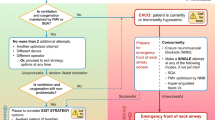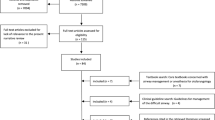Abstract
A 46-year-old woman was scheduled for excision of a malignant peripheral nerve sheath tumor from the neck. The tumor had caused deviation of the trachea to the left and partial obstruction of the superior vena cava. Her upper airway at laryngoscopy after induction of anesthesia was normal. During tumor resection there were transient phases characterized by the complete disappearance of the peripheral oxygen saturation (SpO2) and radial artery tracings. At the end of the operation, the trachea was extubated after ensuring adequate antagonization of neuromuscular blockade. However, immediately post-extubation, she showed signs of acute airway obstruction that necessitated reintubation of the trachea. Laryngoscopy revealed significant edema of the upper airway and vocal cords, requiring a smaller size tracheal tube. Many reports suggest the development of significant airway edema 24 h after such surgery. Our report highlights the fact that this can happen in the immediate postoperative period also. Some authors suggest that, in such surgery, extubation should routinely be done over pediatric tube exchangers. Routine leak testing and direct laryngoscopic/fiberoptic evaluation of the upper airway prior to extubation may also help. While our report reaffirms these points, it also stresses the importance of intraoperative monitoring for the compression of the great vessels, which may serve as a useful indicator of the early development of airway edema.
Similar content being viewed by others
References
Yoshihiro H, Yukihiro M, Takehiro K, Tetsuya T, Satoshi K. A case of postoperative laryngopharyngeal edema following bilateral neck dissection. Practica Otologica (Kyoto). 2002;95:957–961.
Roy S. Acute postoperative neck hematoma. Am J Emerg Med. 1999;17:308–309.
Penberthy A, Roberts N. Recurrent acute upper airway obstruction after anterior cervical fusion. Anaesth Intensive Care. 1998;26:305–307.
Krnacik M, Heggeness M. Severe angioedema causing airway obstruction after anterior cervical surgery. Spine. 1997;22:2188–2190.
Bexton M, Radford R. An unusual cause of respiratory obstruction after thyroidectomy. Anaesthesia. 1982;37:596.
Tanaka A, Isono S, Ishikawa T, Sato J, Nishino T. Laryngeal resistance before and after minor surgery: endotracheal tube versus Laryngeal Mask Airway. Anesthesiology. 2003;99:252–258.
Burkle CM, Walsh MT, Harrison BA, Curry TB, Rose SH. Airway management after failure to intubate by direct laryngoscopy: outcomes in a large teaching hospital. Can J Anaesth. 2005;52:634–640.
Dosemeci L, Yilmaz M, Yegin A, Cengiz M, Ramazanoglu A. The routine use of pediatric airway exchange catheter after extubation of adult patients who have undergone maxillofacial or major neck surgery: a clinical observational study. Critical Care. 2004;8:R385–R390.
Loevner LA. Anatomic and functional lesions resulting in partial or complete upper airway obstruction. Semin Roentgenol. 2001;36:12–20.
Haraguchi HH, Hentona H, Ishikawa N, Sugimoto T, Tsunoda A, Tatsumi A, Komatsuzaki A. Three cases of postoperative laryngopharyngeal edema following nonsimultaneous bilateral radical neck dissection (in Japanese). Nippon Jibiinkoka Gakkai Kaiho. 1995;98:1903–1908.
Burkle CM, Walsh MT, Pryor SG, Kasperbauer JL. Severe postextubation laryngeal obstruction: the role of prior neck dissection and radiation. Anesth Analg. 2006;102:322–325.
Kriner EJ, Shafazand S, Colice GL. The endotracheal tube cuffleak test as a predictor for postextubation stridor. Respir Care. 2005;50:1632–1638.
Miller RL, Cole RP. Association between reduced cuff leak volume and postextubation stridor. Chest. 1996;110:1035–1040.
Fisher MM, Raper RF. The “cuff-leak” test for extubation. Anaesthesia. 1992;47:10–12.
Author information
Authors and Affiliations
About this article
Cite this article
Umesh, G., Ellango, A., Jasvinder, K. et al. Immediate postoperative airway obstruction secondary to airway edema following tumor excision from the neck. J Anesth 23, 609–612 (2009). https://doi.org/10.1007/s00540-009-0798-4
Received:
Accepted:
Published:
Issue Date:
DOI: https://doi.org/10.1007/s00540-009-0798-4




